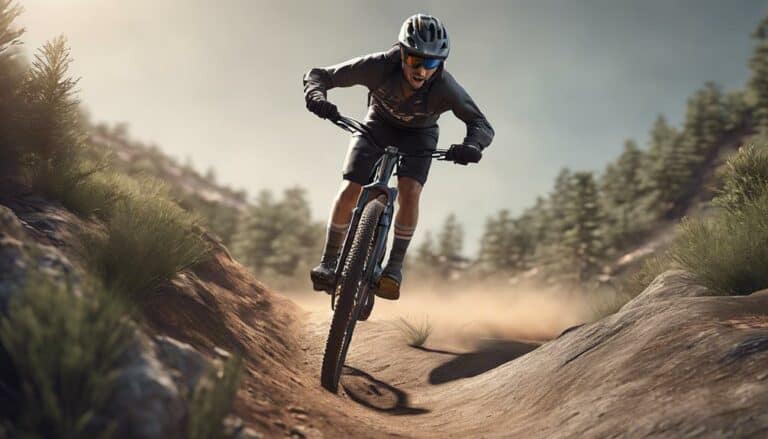When tackling off-camber turns on off-road trails, it's important to finesse your approach for best maneuvering. Ensuring you have a solid grasp of braking techniques and line selection is just the beginning.
But what about adjusting your lean angle effectively or positioning your pedals strategically? These key practices can make all the difference in conquering off-camber sections with finesse and control.
Discover how mastering these techniques can elevate your off-road riding game to new heights.
Key Takeaways
- Leaning bike and body into the turn optimizes tire contact and control.
- Utilize front brake and clutch for stability and controlled speed management.
- Choose outside edge line, adjust lean angle, and maintain pedal balance for success.
- Early terrain analysis, smooth line selection, and throttle control enhance off-camber maneuvering.
Importance of Off-Camber Turn Preparation
To conquer off-camber turns with confidence and precision, thorough preparation is paramount in ensuring peak control and traction on challenging off-road trails. When approaching these turns, your ability to lean the bike appropriately is vital. By leaning the bike to the inside of the turn, you optimize the contact patch of your tires with the ground, increasing grip and stability. Proper weight distribution is also key. Shift your body weight to the outside foot peg and lean your upper body towards the inside of the turn, maintaining balance and control.
Line selection is another critical aspect of mastering off-camber turns. Analyze the terrain early, looking for the smoothest path through the turn. Choose a line that allows you to maintain momentum while avoiding obstacles that could disrupt your trajectory. Additionally, throttle control is essential. Modulate the throttle smoothly to control your speed and prevent loss of traction. By combining these techniques, you can navigate off-camber turns with confidence and finesse, enhancing your overall riding performance on challenging trails.
Braking Techniques for Off-Camber Turns
Implement proper braking techniques before entering challenging off-road trails to optimize grip and control on off-camber bends.
Utilize the front brake to decelerate before the curve while maintaining maximum traction. Applying gradual and controlled pressure on the front brake helps shift weight to the front wheel, enhancing grip on the edge of the tire. Avoid abrupt braking that could lock up the front wheel, resulting in reduced traction and stability.
As you approach the off-camber segment, consider engaging the clutch to regulate speed without sudden braking, allowing for smoother shifts into the bend.
Choosing the Optimal Line
When steering off-camber turns on off-road trails, choosing the best path is essential for maintaining traction and control in challenging terrain. To optimize your line selection, focus on positioning your front wheel towards the outside edge of the camber turn. By doing this, you counteract the natural tendency of the terrain to push you towards the low side, allowing for better stability.
Analyzing the off-camber section ahead can provide valuable insights into the best line to maintain traction. Look for ruts or grooves in the terrain that can offer additional grip for your rear wheels, enhancing your overall control through the turn. It's important to anticipate these features and adjust your line accordingly to make the most of them.
Adjusting Lean Angle Effectively
Adjust your lean angle judiciously to optimize traction and control while managing off-camber turns on challenging off-road terrain. When approaching off-camber turns, proper adjustment of your lean angle is essential for maintaining stability and maximizing tire grip.
Here are three essential tips to help you navigate off-camber turns effectively:
- Lean Into the Hill: To enhance traction on off-camber terrain, lean your bike slightly into the hill. This technique increases the pressure on the tires, improving grip and reducing the likelihood of slipping.
- Maintain Correct Lean Angle: Consistently monitoring and adjusting your lean angle is crucial to prevent sliding and maintain control through off-camber turns. By keeping the bike at the appropriate lean angle, you can counteract the forces trying to push the front end downhill.
- Optimize Tire Grip: By adjusting your lean angle effectively, you can optimize tire grip on off-camber sections, allowing you to confidently maneuver through challenging terrain while minimizing the risk of losing traction. Mastering the art of lean angle adjustment is key to navigating off-camber turns smoothly and safely.
Pedal Positioning for Off-Camber Success
Position your pedals strategically to optimize balance and stability when conquering off-camber trails. Maintaining pedal balance is important for enhancing control and maneuverability on challenging terrain. To achieve this, keep your feet evenly weighted on the pedals to stay balanced and in control. Additionally, lifting the inner pedal slightly will help you avoid striking the ground and maintain stability as you navigate through off-camber turns. This positioning also opens up your hips, making it easier to lean into the turns and maintain traction.
To further emphasize the importance of pedal positioning, consider the following table:
| Pedal Positioning Tips | Description |
|---|---|
| Keep feet evenly weighted on pedals | Maintains balance and control on off-camber terrain. |
| Lift inner pedal slightly | Avoids striking the ground and maintains stability. |
| Position inner pedal higher | Opens up hips for easier leaning into off-camber turns. |
| Bunny hop over rough sections | Smooths out the ride and prevents pedal strikes. |
| Maintain pedal balance | Enhances control and maneuverability on challenging trails. |
Conclusion
Conclusively, mastering off-camber turns on off-road trails requires a combination of skillful techniques and precise execution.
By focusing on braking before the off-camber section, choosing the most suitable line, adjusting lean angle effectively, and positioning your pedals strategically, you can navigate challenging terrain with control and stability.
Remember, practice makes perfect, and with dedication and attention to detail, you can conquer any off-camber turn like a seasoned pro.

